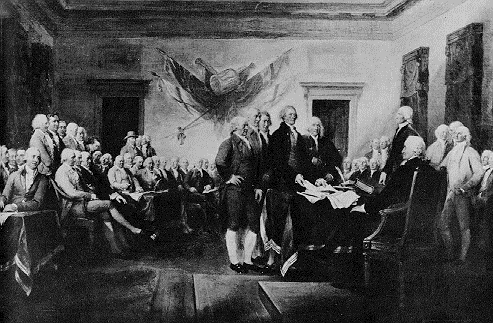 The
signing of the Declaration of Independence
The
signing of the Declaration of IndependenceThe Revolution and Constitutional Experimentation
 The
signing of the Declaration of Independence
The
signing of the Declaration of Independence
| In Tuesday's class, we looked at the breakdown of the British/colonial relationship, caused primarily by two factors: the altered international climate following 1763; and the British decision to reassert their colonial power. The key question--and the correct answer is unclear--is when did the colonists begin to think of themselves as a unified entity--with the Albany Plan? With the Continental Congress? With the Declaration of Independence? |
READING:
four documents:
Read the Declaration and the Articles of Confederation (the plan for the first government of the US) closely; both are very short.
Then, two state constitutions, representing the ideological extremes of the revolutionary experience. First, the Pennsylvania Constitution, which stressed legislative power: read "A Declaration of Rights" and "A Plan or Frame of Government," sections 1-15.
Second, the MA Constitution, which stressed more checks and balances; read "Part the First" only.
The key with both of the constitutions is simply to get the gist of the basic ideas behind the constitutions; I don't care if you know the specifics.
STUDY QUESTIONS:
| 1.) What do you see as the most important difference between the Massachusetts and Pennsylvania constitutions? |
| 2.) Should historians view the Articles of Confederation a "constitution" for a unified country? |
| 3.) Did a "counterrevolution" in constitutional thought occur in the 1780s? |